A Ferrari for the price of a Fiat Panda? That might be pushing it a bit. But if you want a lot of mountain bike for as little money as possible, the second-hand market is your best bet, though finding the right used bike can be like looking for a needle in a haystack… We hope that our guide to buying used bicycles will help you find the pre-loved bike of your dreams.

The market regulates itself, but not always in your favour. Sometimes the high demands placed on a new MTB don’t align with your budget. The obvious solution to this is to buy a used mountain bike. But some bikers are caught in a paradoxical thought process: “Buy a used car? Sure! – Buy a second-hand mountain bike? I’d rather be burned alive!” Even experienced bikers worry about being ripped off or making a costly mistake. If you’re not sure what to look for or what to watch out for, visiting your local bike shop might be your best bet. It’s where the customer is (hopefully) king. If you choose to navigate the second-hand bike market, you might feel like a helpless mouse in a maze of traps. Confusing online listings with no dealer ratings, dubious sellers, or ancient scraps of metal in miserable condition advertised as “as good as new” can really spoil the second-hand bike shopping experience.
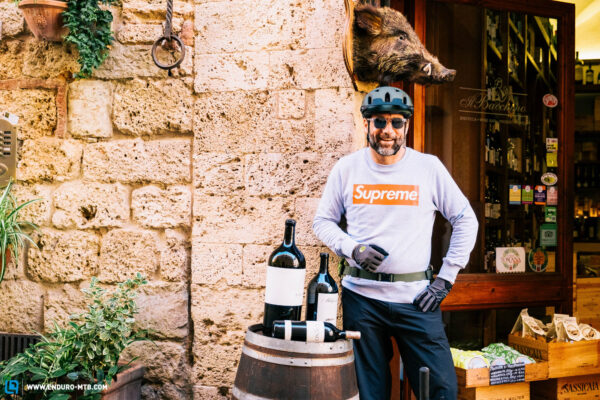

But even sellers aren’t immune to pesky customers who seem to enjoy asking grand questions, such as “How many kilometres have you clocked on sprocket number 7?”, and haggling more than they want the bike itself.
In short, there are great bargains and real treasures hidden among the odd dodgy offers. To avoid frustration for both second-hand bike buyers and sellers, we’ve included the most important points in our guide.
Why buy a used mountain bike instead of a new one?
Sure, used mountain bikes are cheaper than new ones. But there are other reasons not to go all out when buying a MTB. In particular, newbies looking to buy their first mountain bike should avoid blowing all their budget right away. They may think they know what they need, but they often change their riding preferences. Are you looking for a hardtail or a full suspension bike? Do you prefer a fast XC speedster or a touring bike fit for crossing the Alps? Is a trail bike more versatile than an enduro, or is it better to start straight away with a downhill bike? And maybe it’s best to go with an eMTB? These are just some of the many questions that can cause confusion. Before you make a commitment, you should be sure the sport is right for you and consider how and where you want to ride in the future. If you invest too much too early, you may not have the budget to change your choice later to suit your preferred riding style.
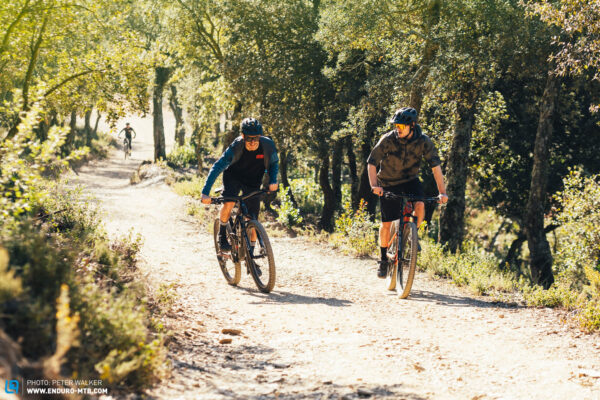

New bicycles are a bit like new cars: their biggest loss of value occurs when you first ride them out of the dealer. But if you get a deal on a used MTB, the depreciation is usually limited. In the best case scenario, you may even be able to resell it for the same price. This can come in handy if you suddenly realise that the bike isn’t right for you.
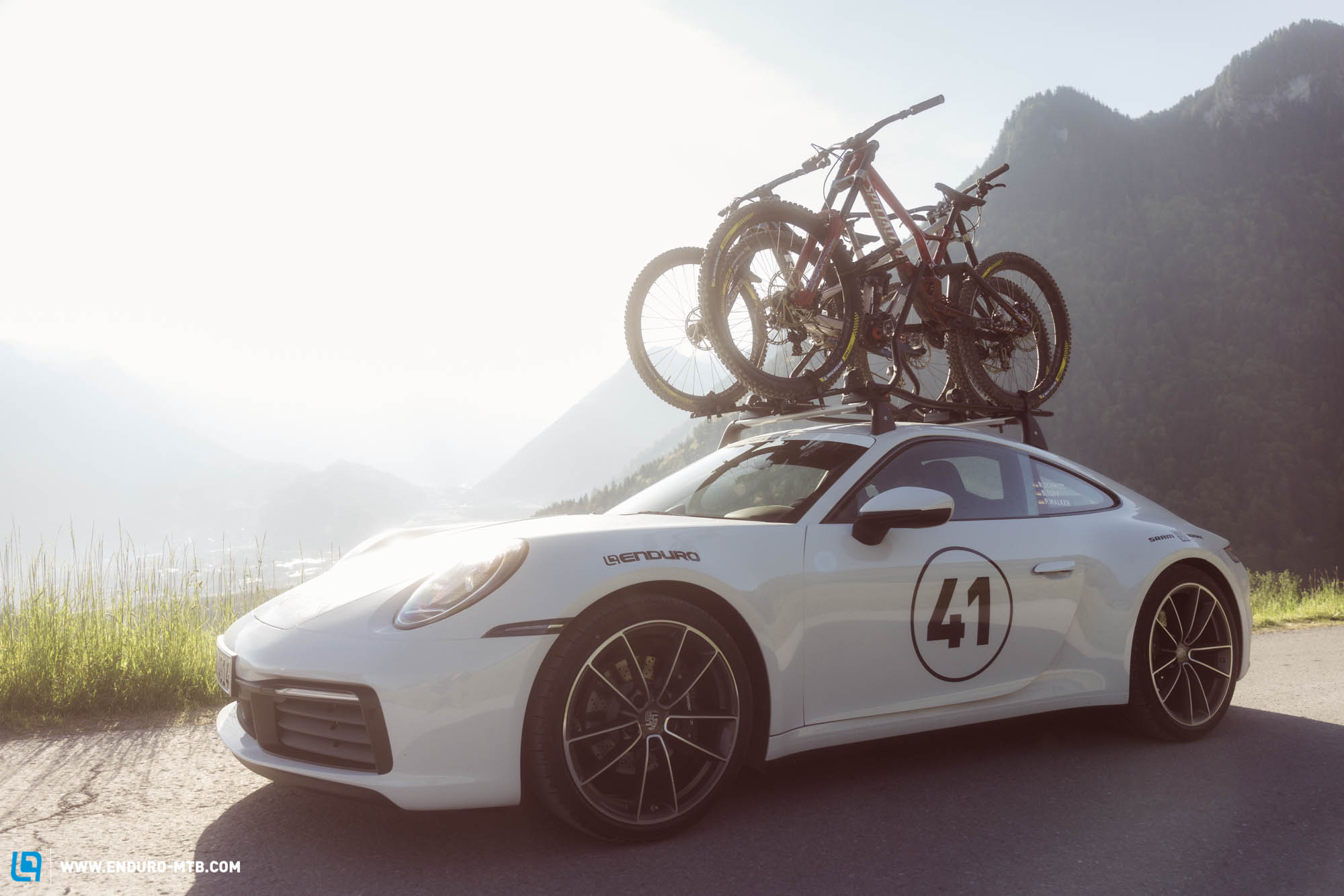
Quick & smart: If you want to make an informed decision on your first purchase, our personalised buyer’s guide will help. It contains a comprehensive set of questions to help you find the right bike faster. Even better, it helps you quickly and independently assess which bikes and bike categories best suit your riding preferences. What’s more, the personalised buyer’s guide recommends a number of exciting and relevant articles for you to read. Make sure to check it out!
A mountainbike with standards – The big change in tire sizes, axle widths and groupsets
Give me more: The bicycle industry is renowned for its rapid technological progress. While a well-maintained used car can still pass as a modern four-wheeled gem after 10 years, a 10-year-old mountain bike is likely to be regarded by many as an outdated veteran. The tried and tested standards are constantly being renewed, improved and discarded, making it difficult to pin-point what the “real standards” are.
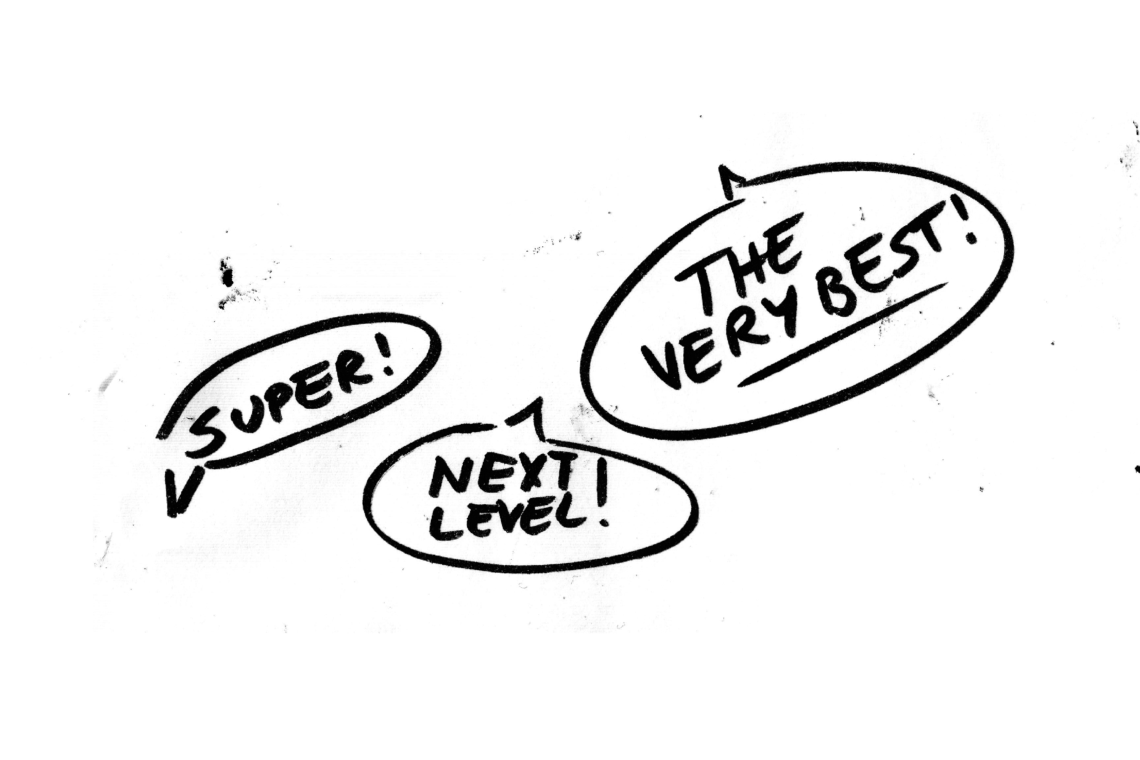
Depending on when your new used bike was made, you may have trouble finding spare parts. Mountain bikes with 26″ tires and drivetrains with front derailleur on the chainring, but without the now standard thru-axle sizes of 15 x 110 mm front and 12 x 148 mm rear, almost disappeared from the market in the mid-2010s But even mountain bikes with a 27.5″ front wheel are mostly discontinued models (apart from frame sizes for smaller riders). Component manufacturers, e.g. for suspension forks, are increasingly switching their range to 29″. So you need to be aware that not every used mountain bike can be easily upgraded with better parts later on, and some may prove more difficult to resell.

To be on the safe side, choose a mountain bike with 29″ wheels, or 29″ front and 27.5″ rear – ideally with a groupset with a single chainring at the front. “Boost” has become the established axle standard, which means 15 x 110 mm at the front and 12 x 148 mm at the rear. However, there are also modern mountain bikes with different axle dimensions, which you can read all about in our Super Boost Plus article.
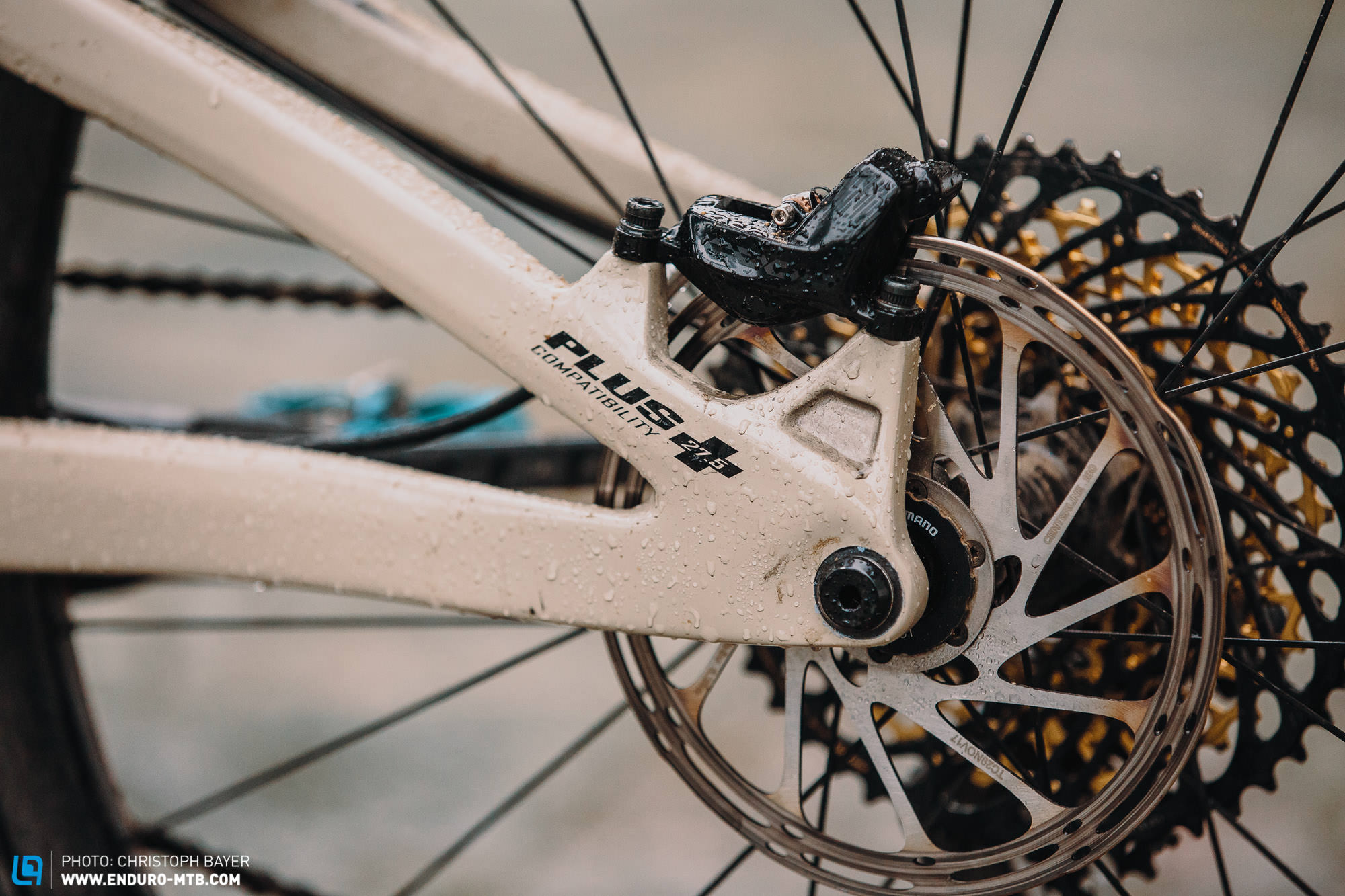
There has never been a universal standard for bottom brackets, but this much can be said: we are saying goodbye to mountain bikes with cartridge bottom brackets. Modern mountain bikes either use press-fit or BSA bottom brackets (with threaded heads).
If you happen to buy a bike without a dropper post, an upgrade will be strongly recommended, necessary even. With the exception of a few expensive electric wireless dropper posts, almost all droppers today have the cable at the bottom, inside the seat tube. So make sure that the frame allows you to run the cable all the way to the handlebar.
Treasure Island – Where can you find used mountain bikes?
Just so you know, if you look at the classifieds in your local newspaper, you won’t find anything. Unless you’re hoping to get your hands on some boomer’s VHS collection of home-recorded episodes of Dallas for a penny… Save yourself the hassle and just look online.

There are three main options for buying the used bike of your dreams:
- From a dealer
- from a private individual
- direct from the manufacturer
Dealers offer a dealer warranty and usually have bikes professionally refurbished. Buying a used bike from a private individual, however, is usually a better deal because you cut out the middleman, but you need to be prepared to deal with minor faults and be familiar with the basics of maintenance and servicing. Having to repair your used bike immediately after you’ve bought will quickly wipe out the savings. The good news is that with our workshop section you can quickly pick up enough knowledge to deal with most technical issues yourself.
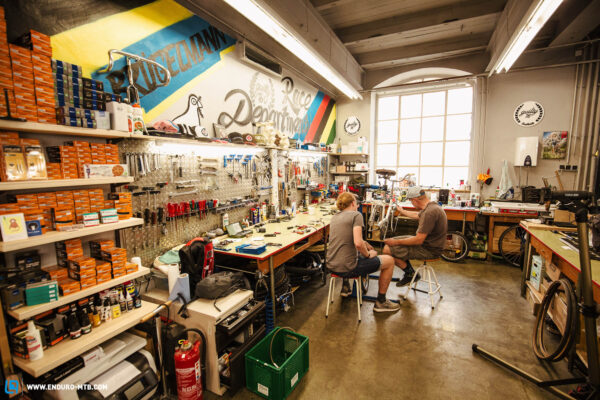
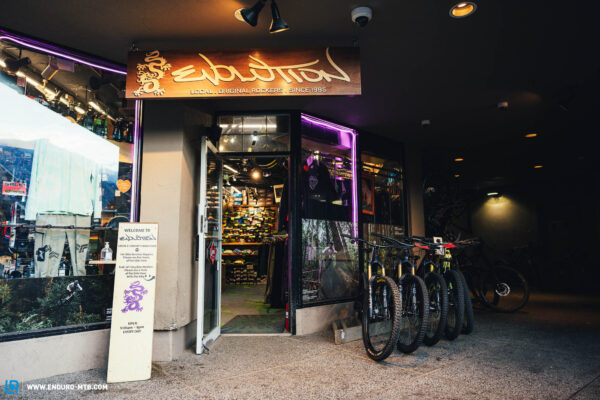
Sometimes it is hard to tell whether you are dealing with a private seller or a commercial dealer. On many online platforms for private individuals, such as bikeexchange.com, professional dealers also advertise used bikes. Buycycle.com is a platform for bikes from private individuals as well as MTBs that have been refurbished in a specialised workshop. At theproscloset.com you’ll only find used bikes that have been refurbished by professionals, and upway.co is a dedicated platform for refurbished ebikes if you’re looking for an MTB with electric assistance. We’d also like to highlight the “Bikemarkt” from our friends at MTB-News.de or the Buy/Sell section at Pinkbike.com to browse for used mountain bikes, components and gear.
If you buy a refurbished bike from a real pro, there is usually less need to worry about the condition of the bike. However, it is also worth checking the reliability of the online platform first. There are not only fake shops on the internet, but also fake professionals.

If you are planning on buying online from a private individual and do not have the opportunity to inspect the bike yourself, you may still be able to get some help. With a bit of luck, you can find qualified bike workshops in the seller’s region using Google Maps, for example. It’s worth asking if they can do a bike check. To be fair, you should share the cost with the seller. That way you won’t be buying blind. Also, if the seller is open to involving an impartial third party, it’s a positive sign that there are no hidden defects on the bike.
The million dollar question: How much is the bike still worth?
Once you’ve spotted your dream bike on an online platform – or elsewhere – you’ll still need to assess its value. Reputable online platforms will give you a general idea. Usually you can reasonably deduct a bit from the listed price because items rarely sell for the asking price. Don’t be afraid to negotiate. Unlike a car valuation report, there isn’t a similar resource for bikes to prevent potential rip-offs, but Bicycle Blue Book is an excellent database that lists prices for numerous models and provides a reliable benchmark based on the condition of the bike.
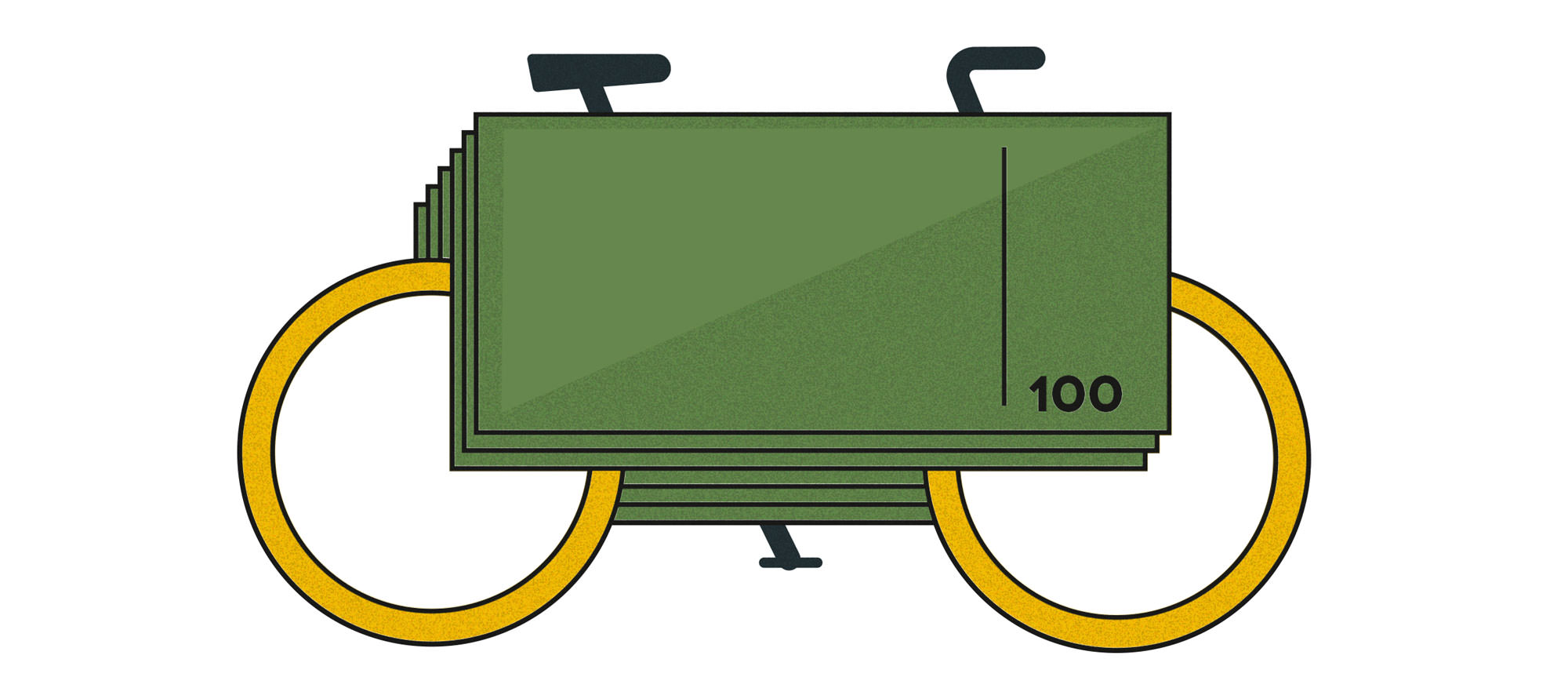
Old gentleman’s bike, only ridden in fine weather, just one previous owner, with a full service history – The seller’s cycling background and the sales pitch
Now we come to the nightmare scenario for introverted penny-pinchers: The personal encounter with the vendor. Skilled negotiators can significantly reduce the price in a face-to-face meeting, while the inexperienced may end up buying an additional year’s supply of brake pad grease. Do you have a skilled, bike-savvy friend? Do yourself a favour and bring them along.
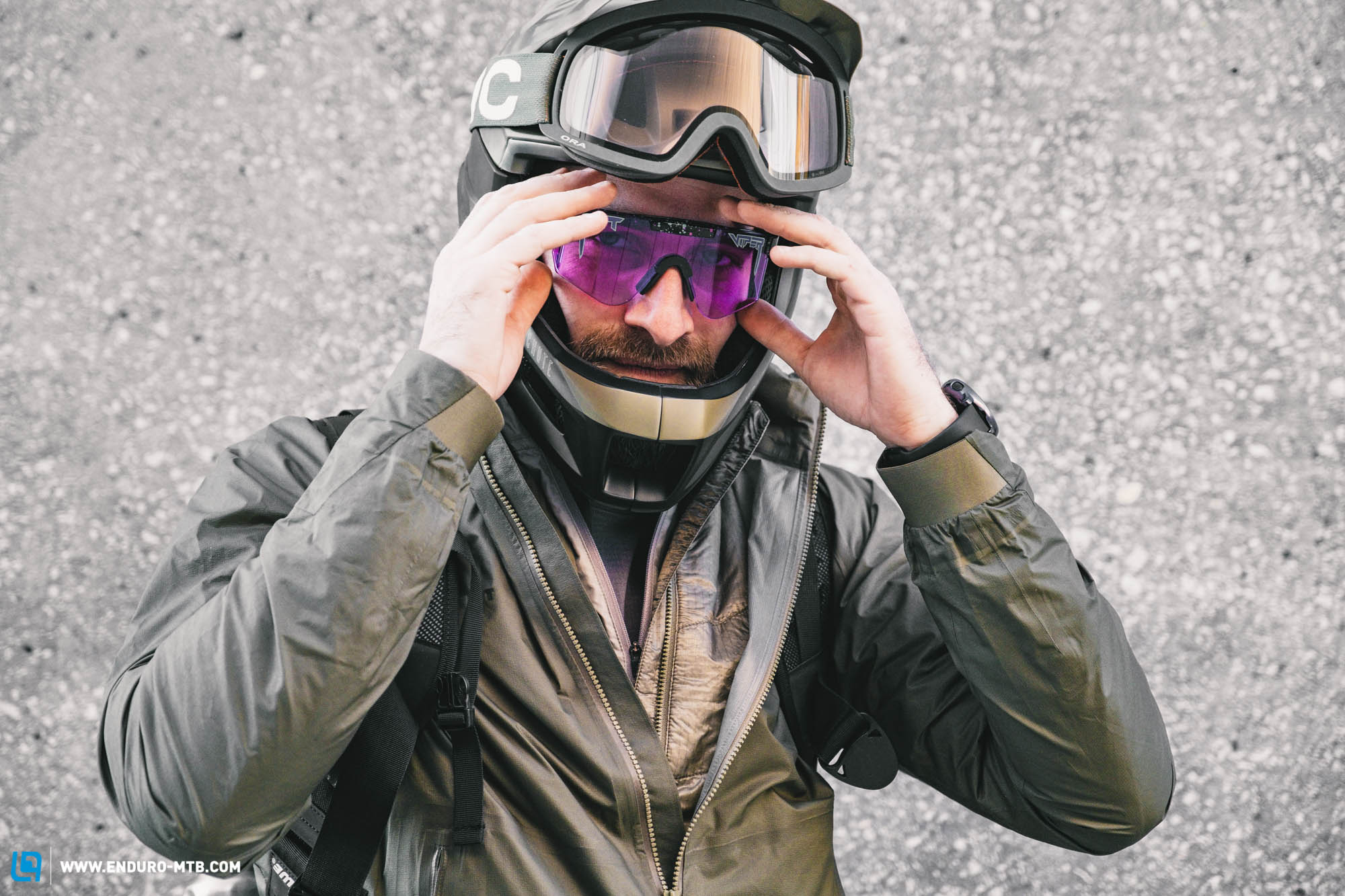
However, if you are travelling alone and this is your first rodeo, here are a few useful tips to break the ice. Top tip: Real bikers don’t greet each other with a handshake. Instead, they slap each other on the forehead with the flat of their hand. Okay, don’t do that, we’re just kidding. Bikers are normal people and you don’t need to pretend to be a fake expert. Sooner or later they’ll find out anyway. Better watch out for red flags on the person you are buying from. If you encounter Josh Bender, Evil Knievel or a scarred biker with two arms in plaster when buying a used bike, you can be sure that the bike has been given a hard time. On the other hand, these daredevils usually know how to keep a bike in good condition and are best placed to tell you about maintenance, service intervals and replaced parts. In some cases, a beginner’s bike can be in worse condition than a professional’s, and the seller may not even know it.

In any case, it’s important to clarify the following questions:
- Is the seller the original owner of the bike and can they provide the invoice?
- If not, what was the condition of the bike when it was bought from the previous owner, and were any damages disclosed?
- What parts have been replaced on the bike and why?
A short, casual transaction where the cash and the bike quickly change hands might not be the best idea. Take your time during the meeting and check that the bike fits your size, ensuring that it fits you well, or can be adjusted the way you need it to. A test ride is essential, but first adjust the suspension to your weight. This step will help ensure that the suspension is really working.
In many classified ads you will read “no bike park use”, or the prospective buyer will ask about bike park use on their own. It is true that you can ride as many up and downhill metres in a bike park in just a few hours as some people do on their own home trails in a year, but that doesn’t mean you can draw general conclusions about the condition of the bike. There are bike parks with smooth flow lines that could be ridden on a road bike, and home trails of mountain hermits that are reminiscent of a full-blown Red Bull Hardline.
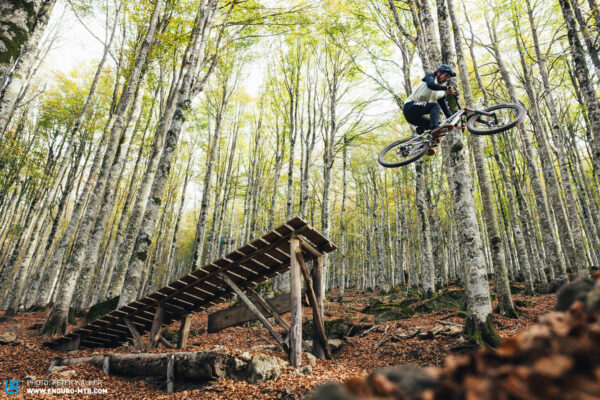

Our tip: Try to build up a relationship of trust with the person you’re talking to. Instead of greeting the seller with a 14-page sales contract, humourless legal advice and firing off irrelevant questions, ask for tips for a bike holiday. A simple chat can often tell you more about a bike’s wear and tear than a detailed logbook. If the seller has already bought their replacement bike, consider arranging a test ride together. Ideally, you will not only find a new bike, but also a new biking buddy.


Does the conversation fail to build up any real trust, or do you end up with a dodgy salesperson and still have doubts, but the offer is too tempting to pass up? If so, get a pen and paper and write down everything the other person has promised you. Sales between private individuals usually take place under exclusion of any warranty (depending on the legal situation in your region). Sellers protect themselves with exclusion clauses such as “bought as seen”. If the bike breaks down in the first few metres and a dispute arises, at least you have something in writing to refer to.
However, even if the transaction was carried out with confidence and left you with a good feeling, the used bike may have hidden defects that the honest seller was not aware of. In the case of a private sale, there is usually no liability. An invisible crack in the head tube or a fracture in the frame underneath the pristine paintwork can quickly turn what you thought was a bargain into a money pit. A specialised bike insurance can protect you from the worst. Most of them also cover used bikes. After a waiting period of 3–6 months, defects and wear and tear are also covered. The insurance premium depends on the original price of the bike, and is usually between € 100 and € 200 a year. But beware: insurance coverage is usually limited to bikes up to 3 years old, isn’t available in all regions, and is subject to a number of exclusions.
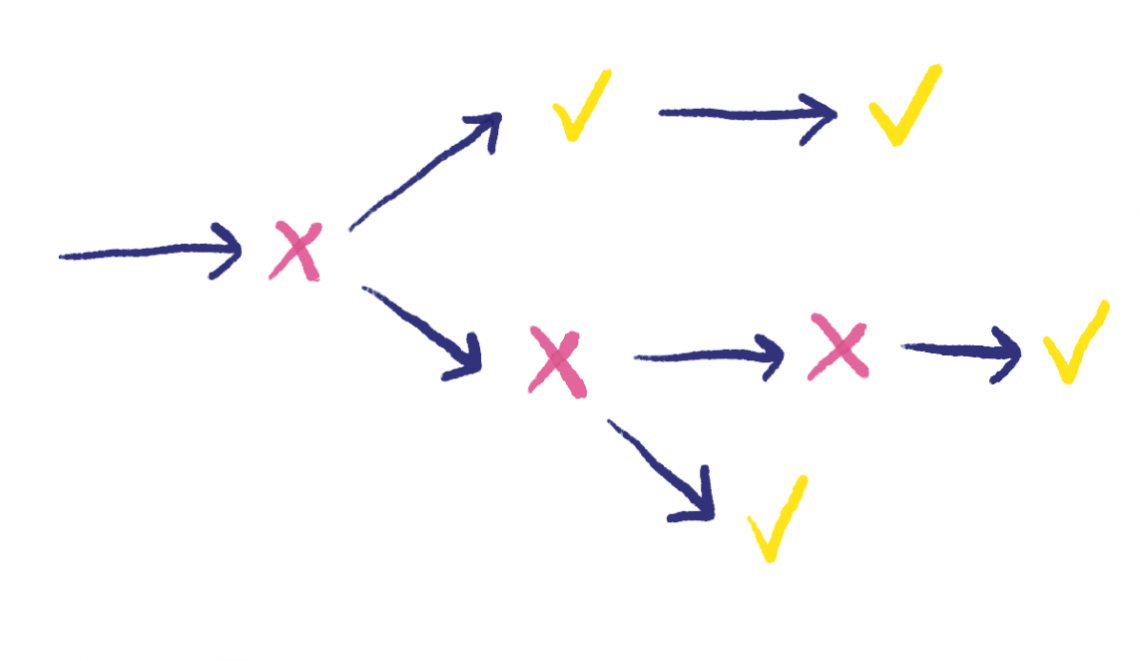
The checklist
Now it’s time to get down to business: the components check. New or used, a bike is more than the sum of its parts. But if its components aren’t working properly, even the best mountain bike won’t perform well. Here is a checklist of things to look out for.
The frame
The frame of a bike is like the foundation of a house. Before you view the bike, find out what the frame’s weak points are. You can exchange information and experiences with other owners on bike forums. But always take such information with a pinch of salt. The internet is the Wild West of personal opinions, and for every single understatement there are four exaggerations.
Watch out for dents and dings in the frame. Dents in the paint can occur anywhere, but the down tube is particularly susceptible to damage from debris kicked up by the front wheel. If the previous owner applied a protective film to the paintwork, you have to give them credit for that. Cracks often appear near weld seams, and signs of wear can be found where the chain and cables run close to the frame. The chainstays and top tube can show scuff marks from contact with heels and knees. If a component appears significantly newer than the rest of the frame, it may have been replaced. It doesn’t hurt to ask, just casually mention it to the seller.
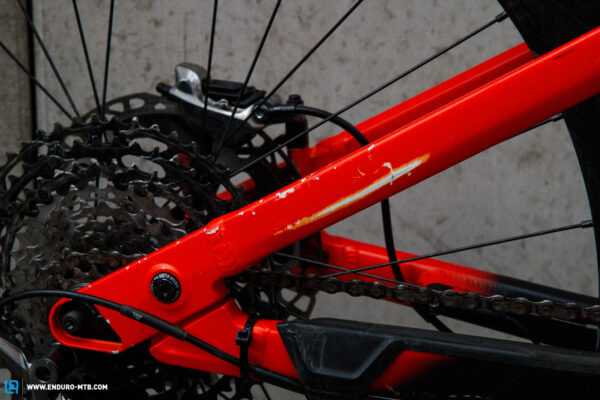
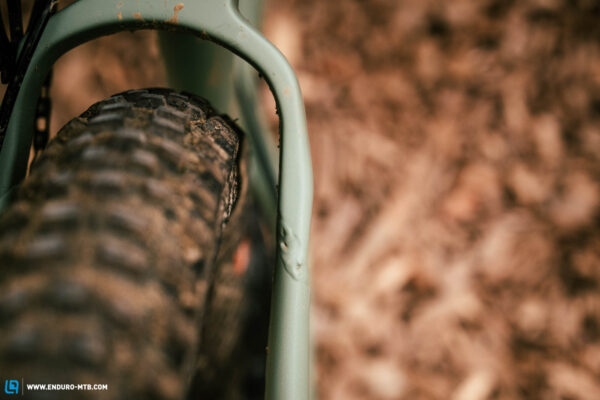
Used carbon bikes is where opinions are divided. For some, carbon represents the ultimate high-end performance material, while others steer clear of used carbon bikes for fear of potential hidden frame damage that could lead to material failure in extreme situations. Let’s put it like this:, both aluminium and carbon can be destroyed and neither has a special seal of quality. We look at this in more detail in our article on carbon myths.
Taking the time to build up trust with the seller from the very first “hello” can pay off in two ways. More and more bike manufacturers are offering generous guarantees on frames that go well beyond the warranty required by law. The catch is that they usually only apply to the first owner of the bike. If you are on good terms with the seller and there is a defect in the frame, the seller (if they were the first owner of the bike) can contact the manufacturer on your behalf and make a warranty claim. So be nice and bring a box of chocolates to the meeting.
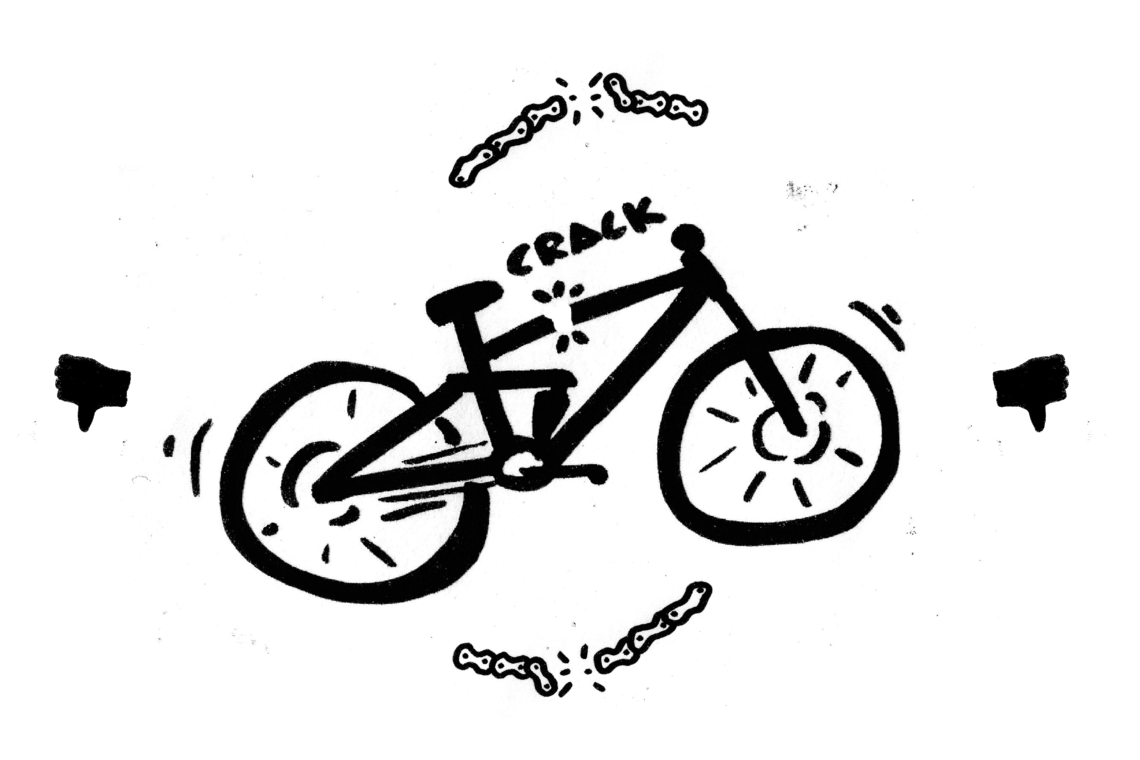
Checking the frame includes checking the bearings. Is the first set of original bearings still in place, have they been replaced and what is their condition? To check for play in the headset bearings, first check that the suspension fork is firmly seated in the frame. With your left hand, lock the front brake and place your other hand between the fork crown and the head tube. Then move the bike forwards and backwards. A rattling noise can indicate a worn headset bearing, but the play can also be caused by worn bushings in the suspension fork or even some play in the moving parts of the brake. You can check the suspension fork for play by similarly placing your hand between the stanchion and the lower legs, while pulling the front brake with your other hand and rocking the bike back and forth. If the tubes move horizontally in relation to each other, this may also be the cause of the play. To assess the brake play, apply the front brake and move the tire back and forth with your free hand. If there is play, check that the calliper and disc are properly tightened.

For the bearings in the rear triangle, use a similar method as for the headset bearing. Place one hand on the rear wheel and hold it in place while pulling on the main frame with the other hand. If you feel any movement, repeat the process between the individual stays and links connected by the bearings until you have identified the culprit. Getting replacement bearings for many bikes is neither difficult nor expensive, but removing and installing them can be a challenge for inexperienced mechanics. If you don’t have the right tools for fitting the bearings, factor a visit to the bike shop into the purchase price. When checking the bearings, check the axles and the bolts that secure the rear triangle. Faulty Allen key slots or damaged threads can be easily overlooked and can prove difficult to replace, especially on older models.
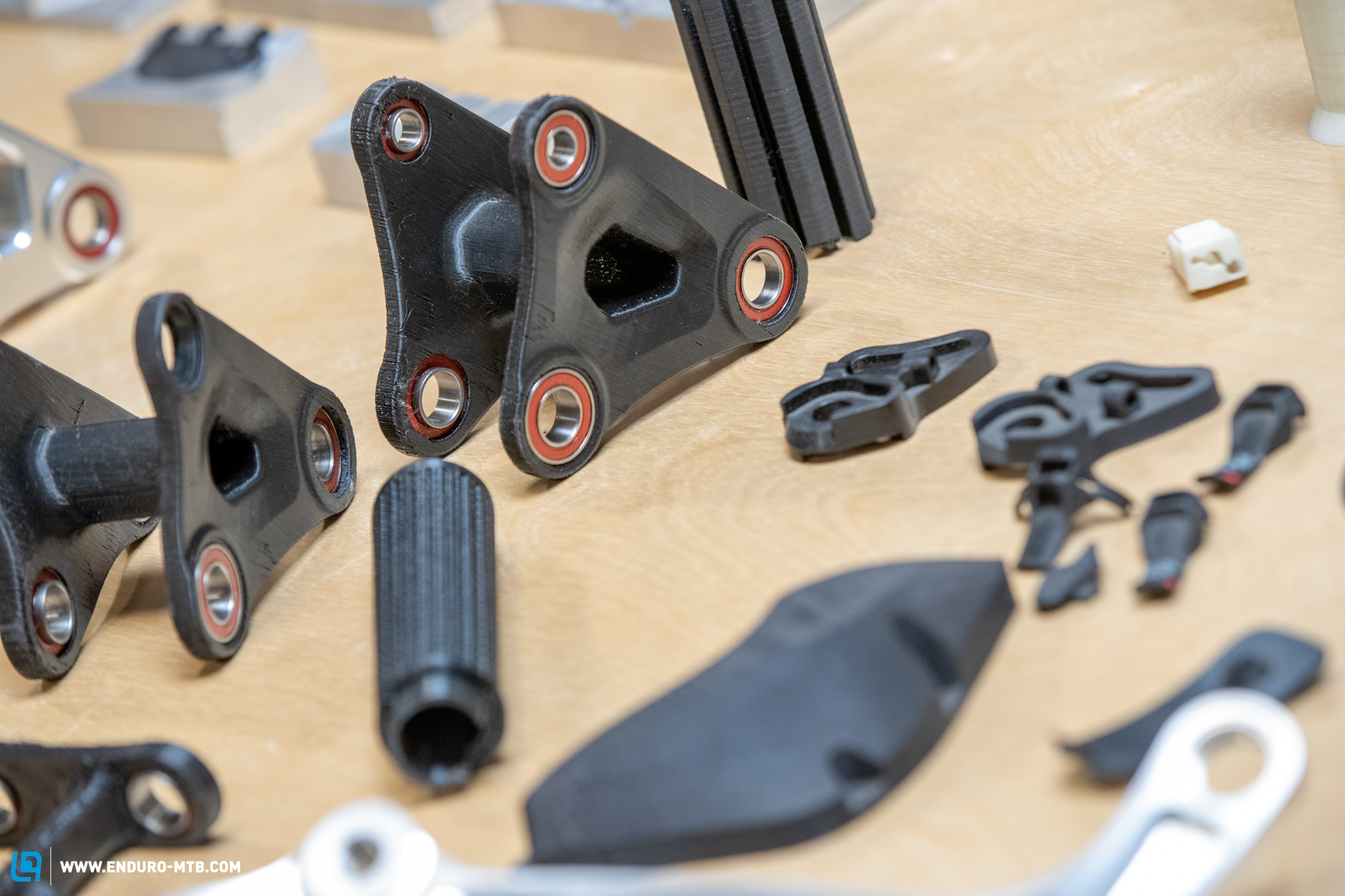
The suspension
Three facts about mountain bike suspension:
- The suspension has an enormous influence on the feel of the bike.
- The suspension needs to be serviced regularly to keep it working properly, and
- 90% of all bikes are serviced too infrequently.
Did the previous owner keep to the service intervals or even have the suspension components professionally overhauled? Great, there are probably invoices for this. If not, set aside another € 100–200 for the service. You should also consider investing in servicing the bike if it has been stored for a while, even if it had been serviced just before being put into storage.. You can do the lower leg fork service yourself, and it’s a good exercise to get to know your bike. If the suspension elements have been neglected, take a little more time to check them.
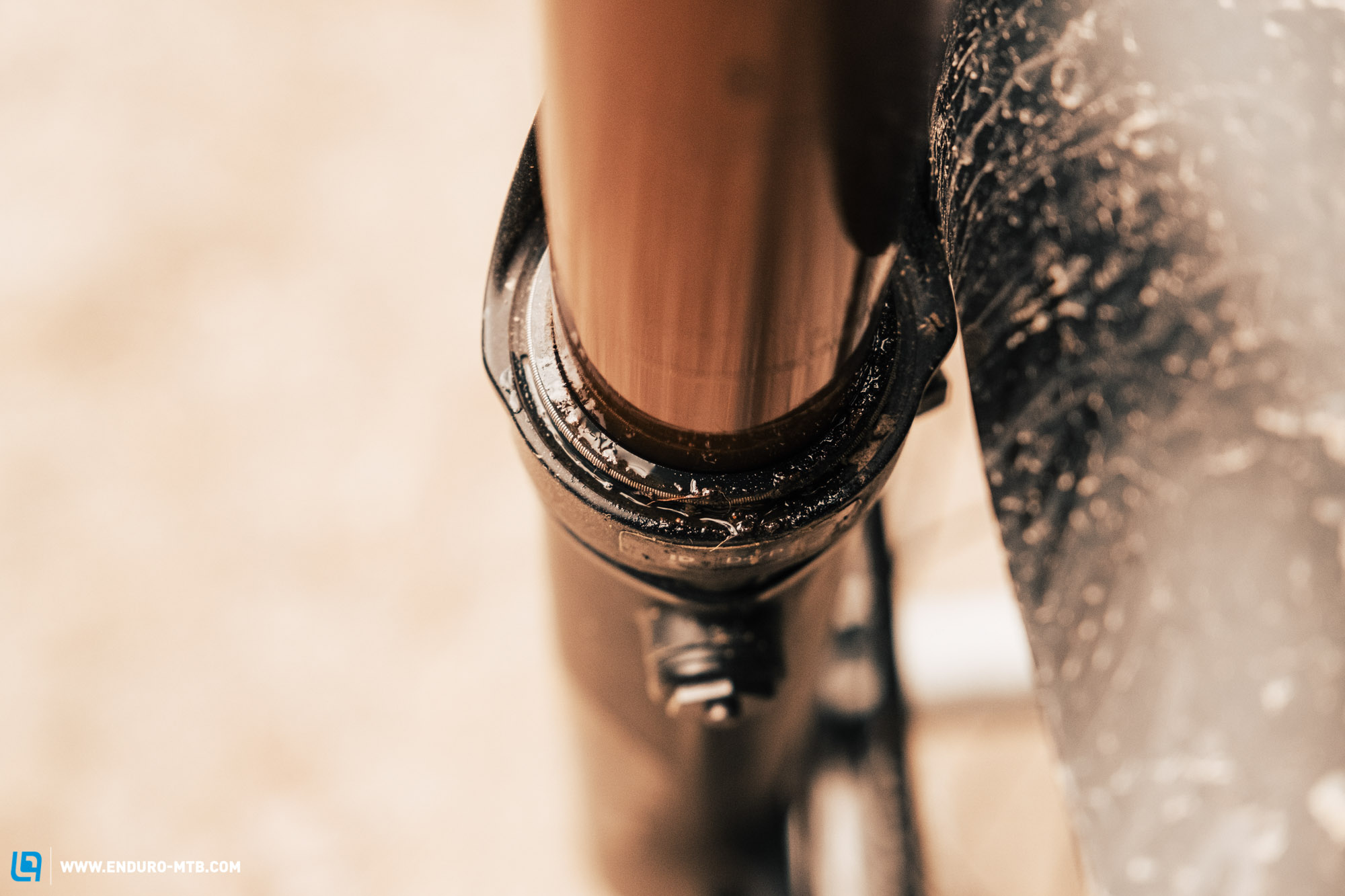
First check that the fork and suspension stanchions are free of dents and scratches and whether the stanchion seals are porous or still in good condition. When stationary, does the fork compress when you press the handlebar and the shock when you push on the saddle? Do the suspension elements compress without any noticeable sticking, or do you have to apply a lot of force for the first few millimetres? Poor responsiveness is a sign of neglected suspension maintenance. Next, adjust the rebound setting on the fork and shock and repeat the test. If the rebound speed has changed, the rebound is OK. If the speed remains the same, the suspension needs service.
The wheels
Wheels are usually the second most expensive component on a bike after the suspension, and sometimes they’re the most costly. Throughout a mountain bike’s lifespan, the wheels may fall out of true, and issues like hub play, and hairline cracks on the rim can develop. If the wheels don’t sit firmly on the axle between the fork and the rear triangle, it’s usually a sign of play in the hub bearing. This problem can often be fixed quickly with a pair of cone spanners, which you can borrow from your local cycle shop. However, there are wheels where the bearing play cannot be adjusted. In these cases, a new bearing is required and you will have to pay an additional € 40 per wheel.
The next thing to check are the rims. Dents in an aluminium rim may indicate rough handling by the previous owner. A small dent isn’t usually a problem, as long as the rim flange is strong enough to hold the tire bead securely. With tubeless tires, you can test it by pressing both thumbs against the tire sidewall just above the dent. The tire shouldn’t lose air. However, if the dent is large enough to deform the rim by several millimetres, or even cause a crack, you should replace it.
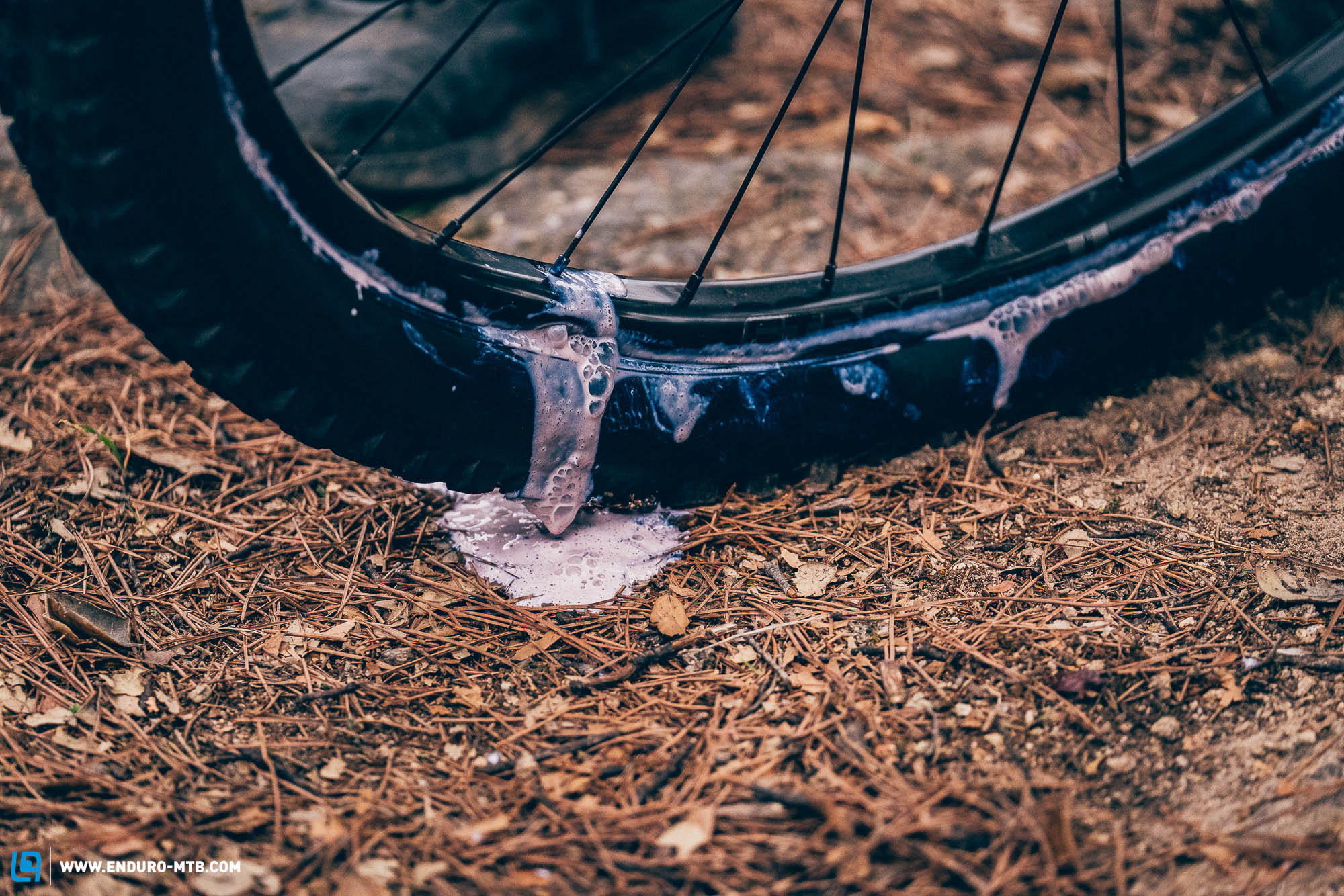
The easiest way to check if a wheel is running true is to lift one side of the mountain bike and turn the wheel quickly. If the tire is properly seated on the rim, a wobble will indicate if the wheel is out of true. However, you’ll need to hang the bike on a work stand or turn it upside down to detect smaller defects. You can either place a finger on the rim or attach a shortened cable tie to the fork lower legs, or one of the stays. Any movement of the rim, either up and down or away and towards in relation to this fixed point, indicates that the rim isn’t running true. If the wheel isn’t perfectly trued, it’s not the end of the world. With a little patience, adjusting the spoke tension can help to centre the wheels.
Talking about spoke tension: Loose spokes are a sign of a neglected bike. While checking the spoke tension by simply squeezing a pair of spokes together with two fingers, you can also look at the spoke holes in the rim. If you find small hairline cracks in the rim, either the spoke tension was wrong or the wheels have been ridden hard. Either way, the rim has entered the final chapter of its life. Keep a close eye on this area, and if it gets noticeably worse, or you have to constantly adjust the spoke tension, it is best to replace the rim.
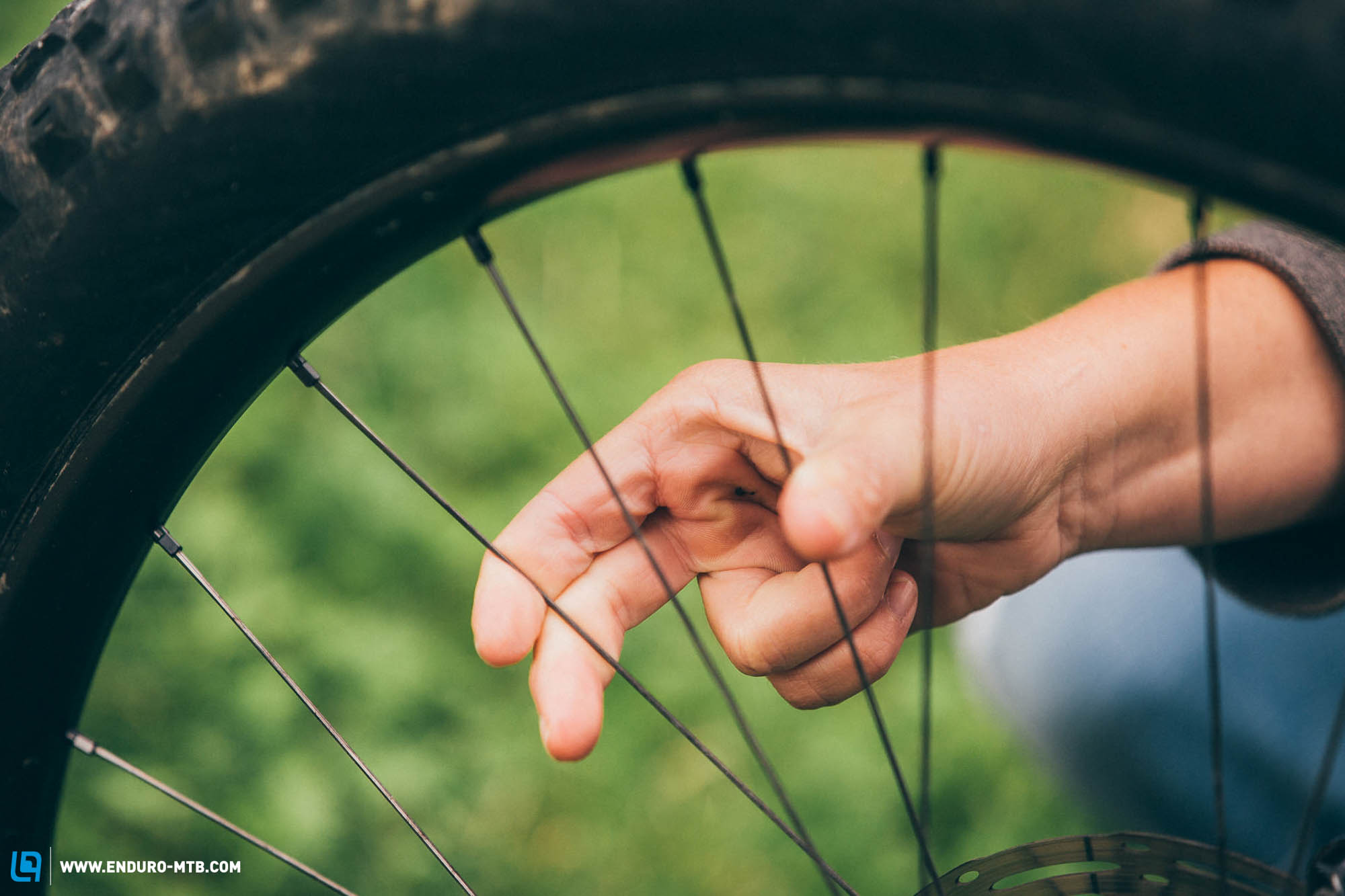
There are some special considerations for used bikes with carbon rims. Carbon rims can go out of true, which can be corrected by adjusting the spoke tension. In most cases, however, the misalignment isn’t so pronounced because the rims are inherently stiffer. But, you must be very careful when centering and it is best to check the spoke tension with a precise tension gauge to avoid damaging the rim.
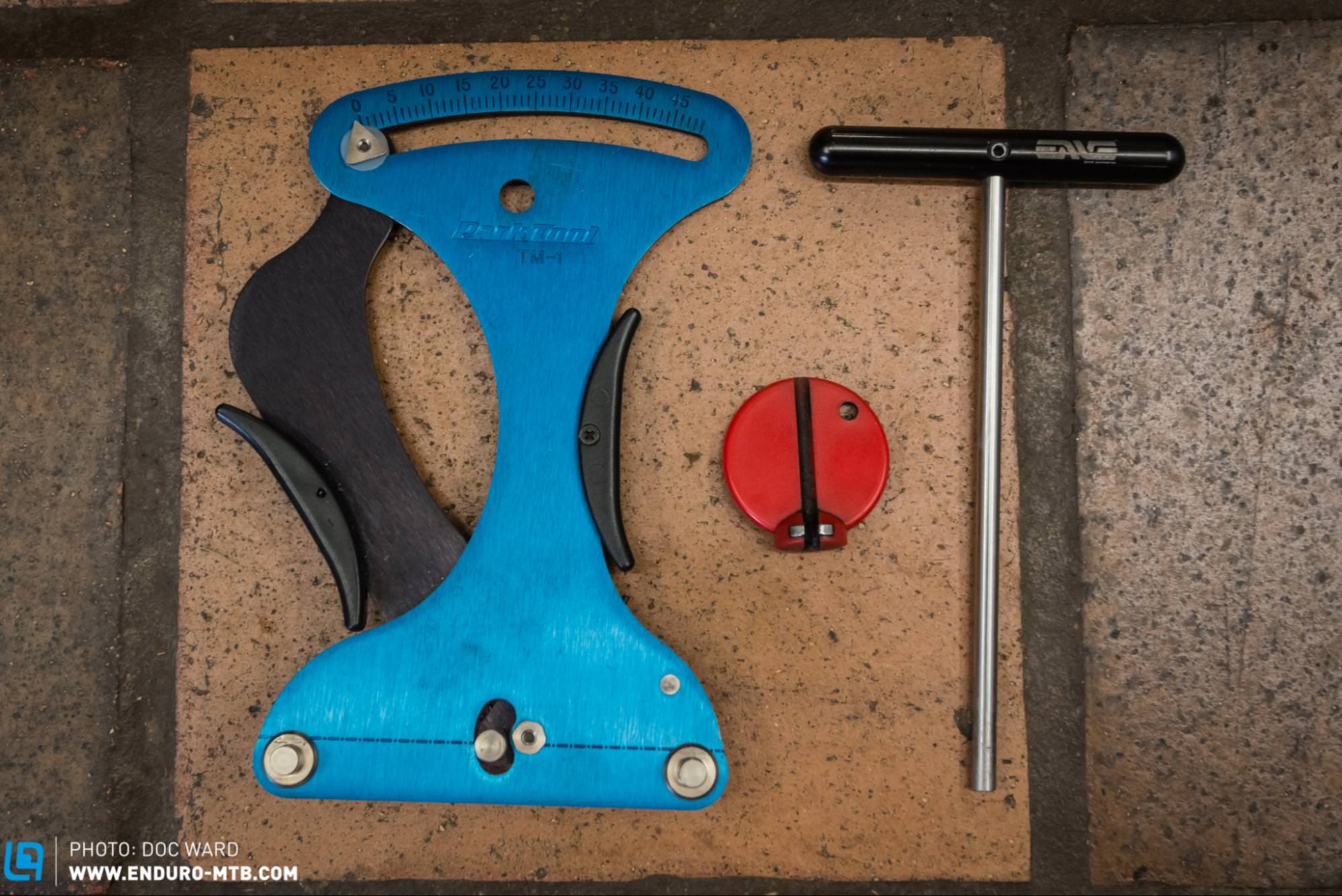
Dents and even small cracks in carbon rims, are a no-no. Even though you may see testimonials online with riders claiming that they have survived an entire season on broken rims, we strongly advise against it. It’s safer and smarter to invest in new wheels or ask the original owner if the manufacturer offers a wheel replacement service. Similar to frame warranties, you may be eligible for a relatively inexpensive or even free replacement.
The brakes
Brake discs and pads are wearing parts and will need to be replaced sooner or later. When it comes to brake pad thickness, the thicker the better. A look inside the calliper will reveal the condition of the pads. If you notice that the pad material on the backing plate is thinner than 1 mm, you should remove the pads from time to time to check that there’s still enough pad material and that it’s evenly distributed on all sides.
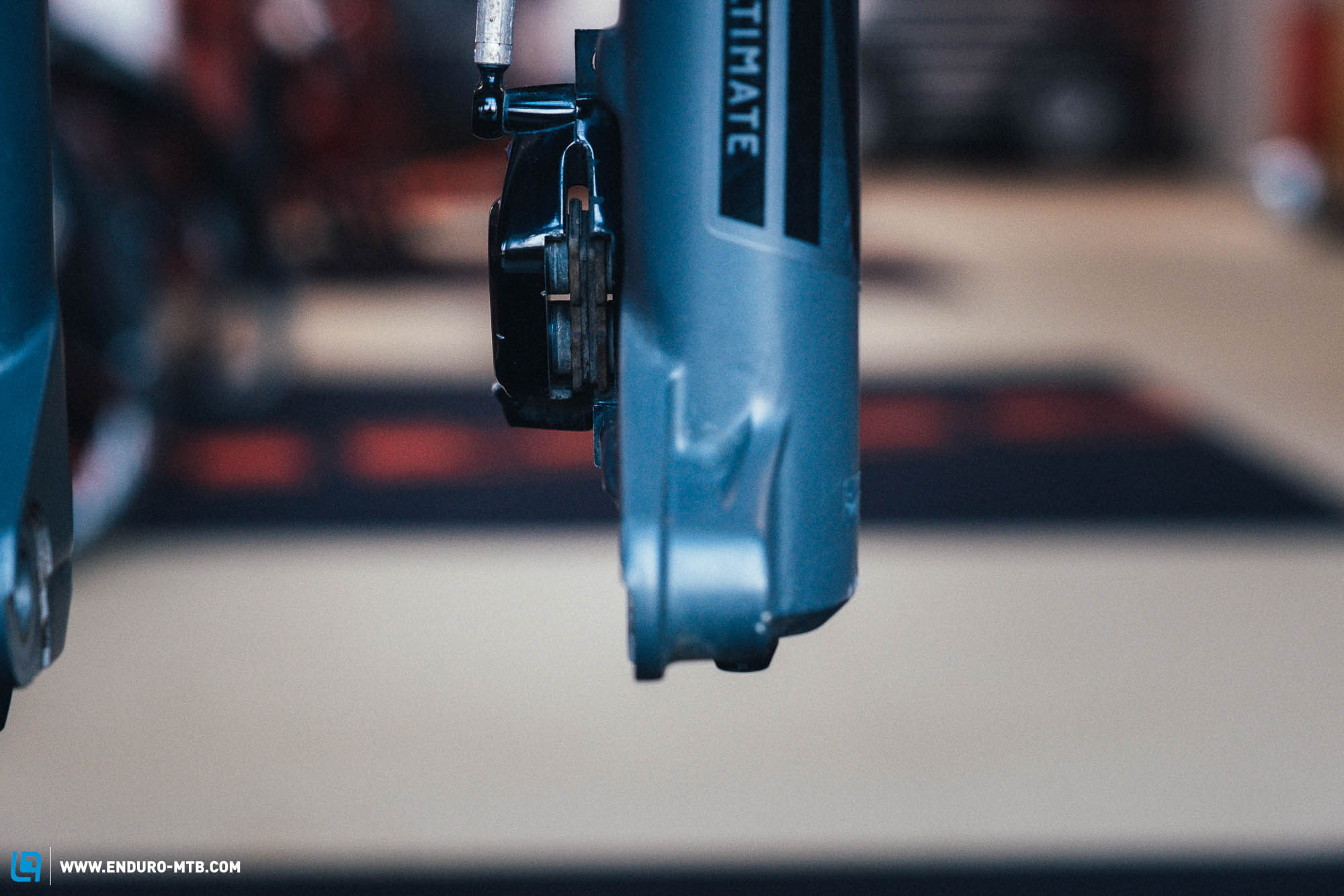
The minimum thickness of the brake disc is usually indicated on the disc and can be checked with a calliper gauge. On one-piece discs, if you can feel a pronounced ridge between the braking surface and the rotor spokes when you run your finger along, that’s a sign that you might have to replace the disc soon. Marks or severe discolouration also indicate significant wear, and replacing the discs is probably a good call.
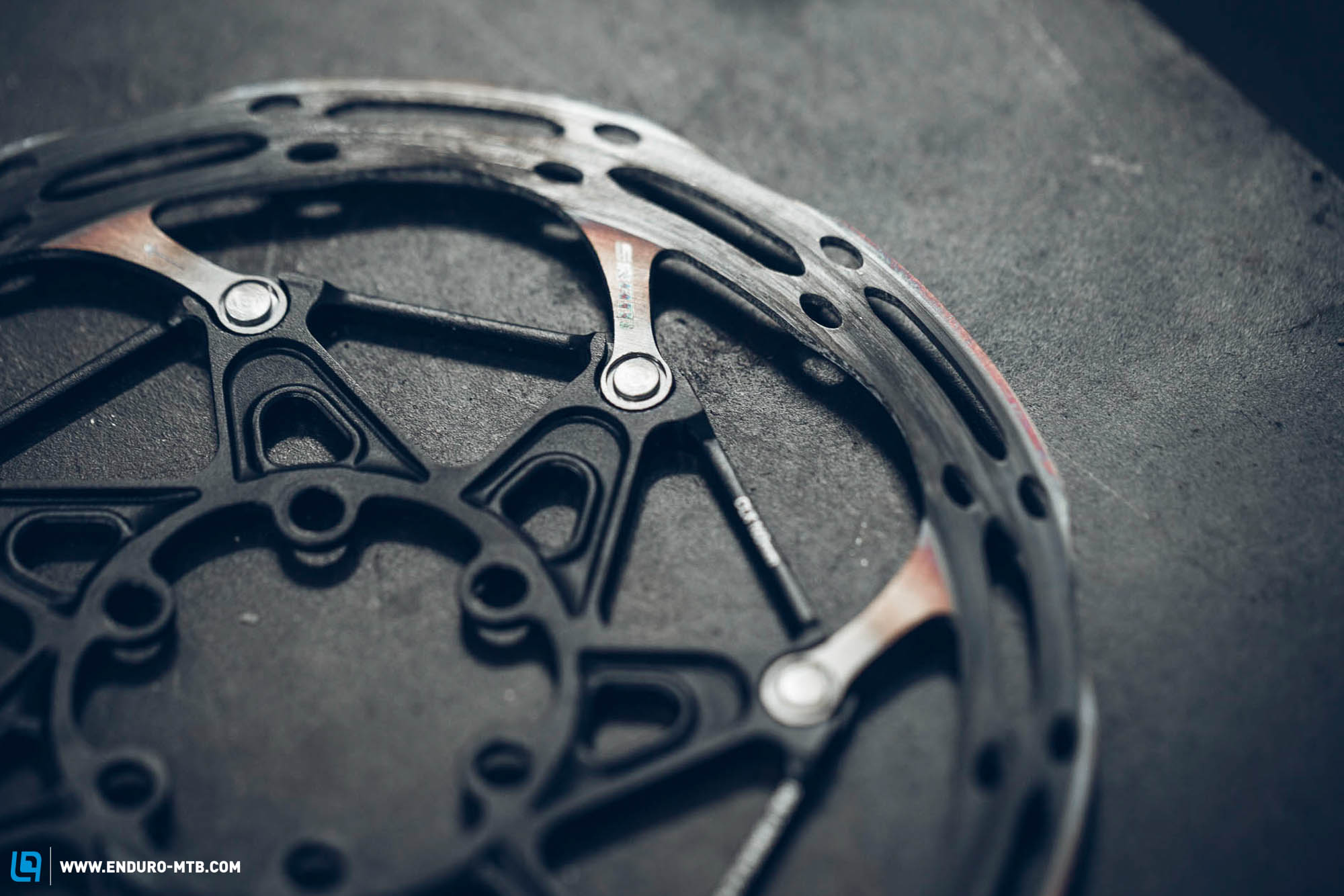
A thorough brake test is the best way to check the brakes. Some models, particularly those with metal pads, may need to be warmed up to achieve optimum bite and a firm pressure point. If the brakes continue to feel spongy after several brake tests, they may need to bleed them to make them work again. A professional will normally charge just under € 40 for this service, which you can factor into the negotiation price. With the brakes working fine, we’ll guide you through the process of setting up the brakes.
The drivetrain
The drivetrain is even more prone to wear than the brakes. So be prepared and buy a chain wear guide, an essential tool that costs only a few euros and should be part of every cyclist’s toolkit. This tool will tell you if your chain is stretched and worn. It also gives you a professional edge during a sales pitch ;).
Even without a chain wear guide, you can check the condition of the cassette or chainring. Look for exposed, sharp teeth on individual sprockets and see if the rear derailleur has difficulty shifting gears during a test ride. If these problems occur, schedule some time in the workshop. In most cases, either the rear derailleur needs to be adjusted or the rear derailleur hanger is bent. Both issues can be fixed with a bit of manual dexterity at no extra cost. However, severe wear on these parts can lead to higher expenses. Depending on the groupset, a new cassette can cost several hundred euros, and it’s advisable to replace the chain and chainring at the same time. A stretched chain can accelerate the wear of the cassette and cause it to jump over the teeth of the sprockets. Fresh components tend to work together better and improve overall performance.
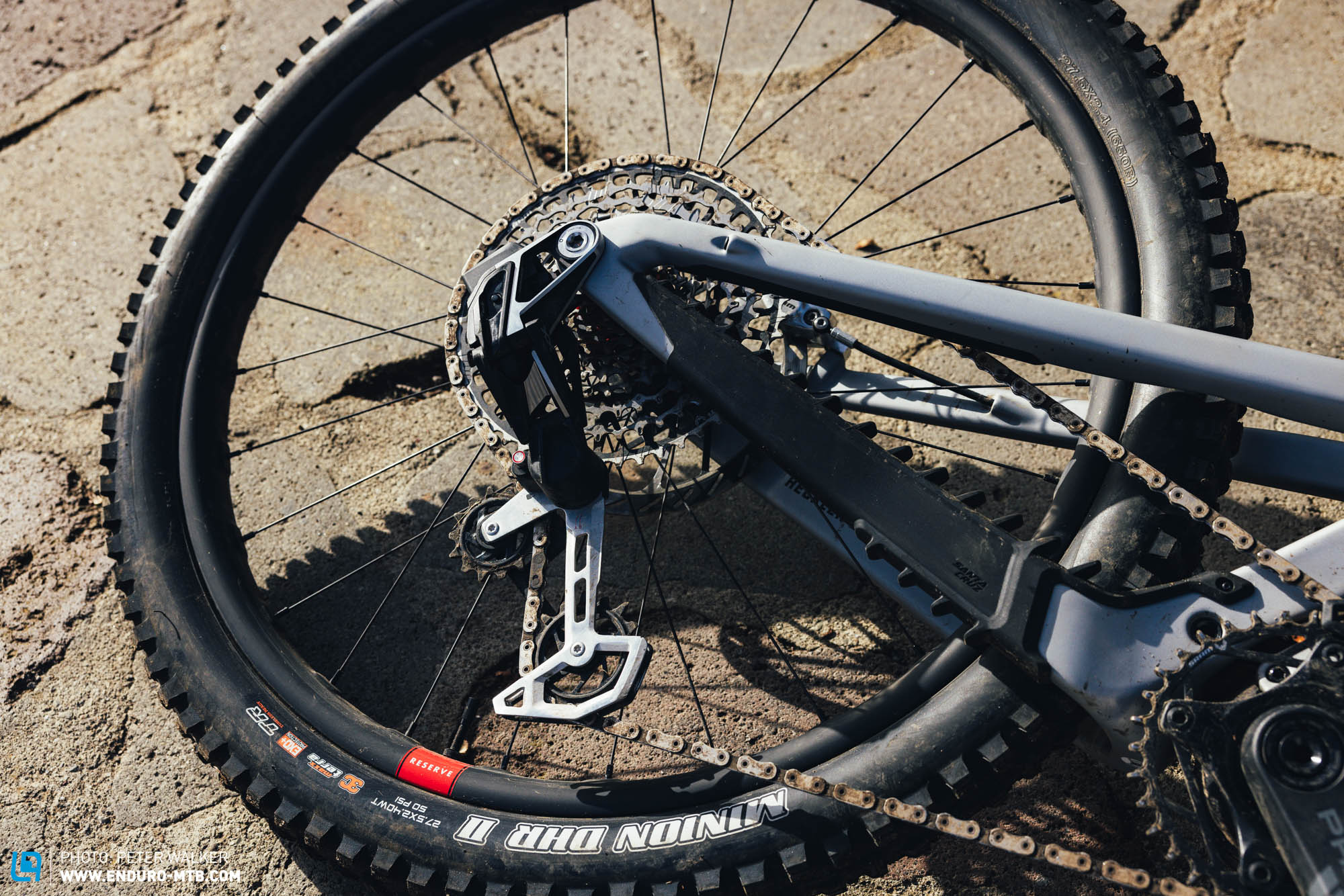
The tires
Tires make the top of the list for wear and tear, even more so than brakes and drivetrain. Once they’re worn out, you can easily spend € 100 on a set of your favourite tires. Our big tire group test will help you decide which ones are right for you.

Even unused tires can deteriorate if they’re not stored in a cool, dry place away from direct sunlight. If the bike has been left standing with a flat tire for a long time, the sidewalls of the tire may have become damaged or cracked. That’s why it’s a good idea to check the tires when buying a used bike. You should also check whether the previous owner converted the bike to tubeless. If not, we strongly recommend doing it. We provide the tubeless conversion guide for free, but the rim tape, tubeless valves and sealant will cost you around € 30.
The seatpost
By seatpost, of course, we mean a dropper post. You’re not seriously considering a bike without a dropper post, are you? Does the dropper still extend smoothly all the way to the top, and doesn’t sag when you sit on it? Is the stanchion free of scratches and does the remote lever still work smoothly? If not, some problems can be solved with some dropper post maintenance. If the dropper is beyond repair, you’ll have to spend another € 200 or so on a new one. For a comprehensive overview of the market, check out our dropper group test.
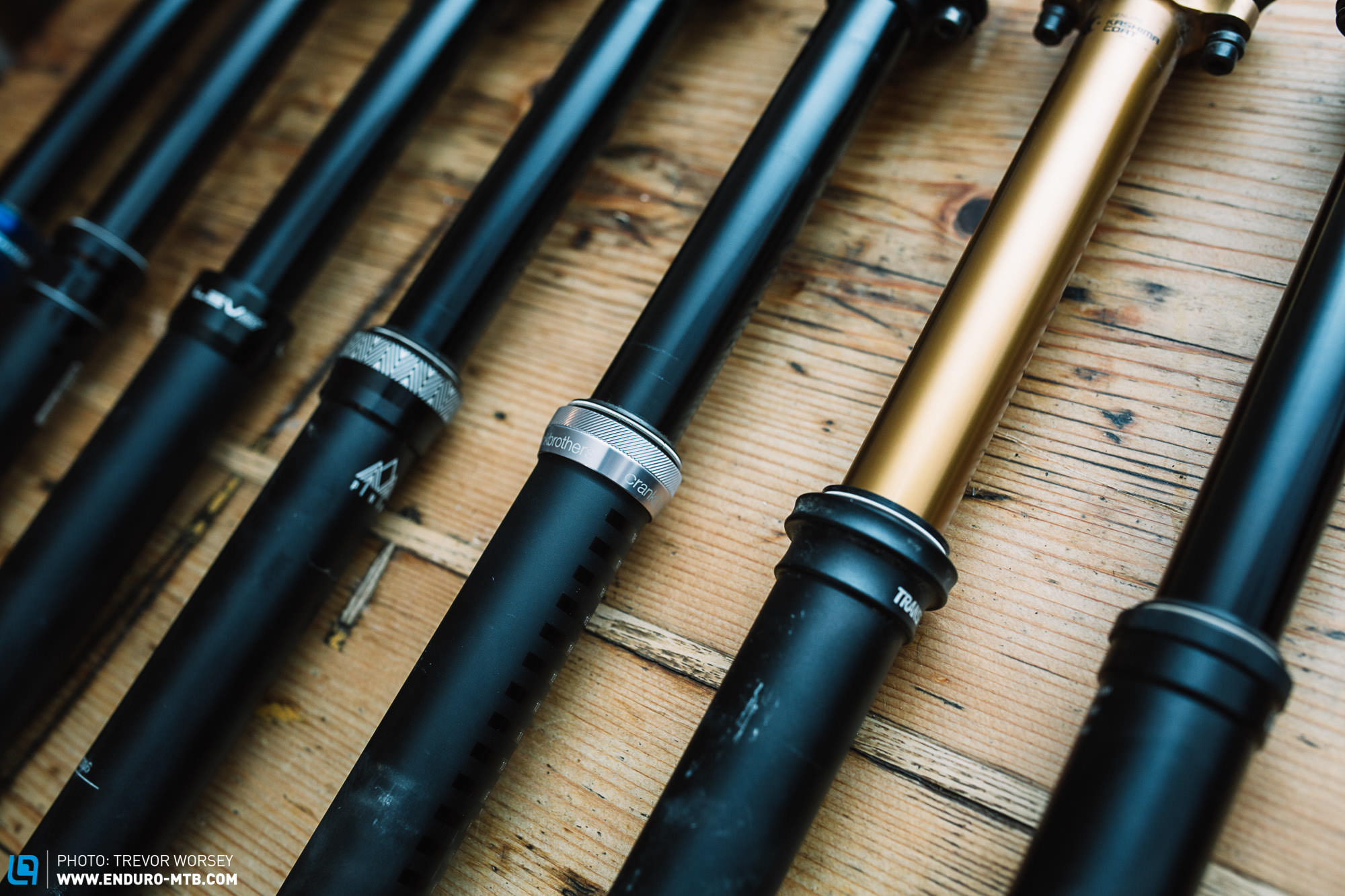
Have you ticked all the boxes on your checklist, nabbed the bike of your dreams and got the paperwork sorted? Then you’re almost ready for the next bike season! In addition to the component checklist, you should also review the pre-season checklist as summer draws near. Once that’s done, there’s no stopping your bike adventures!
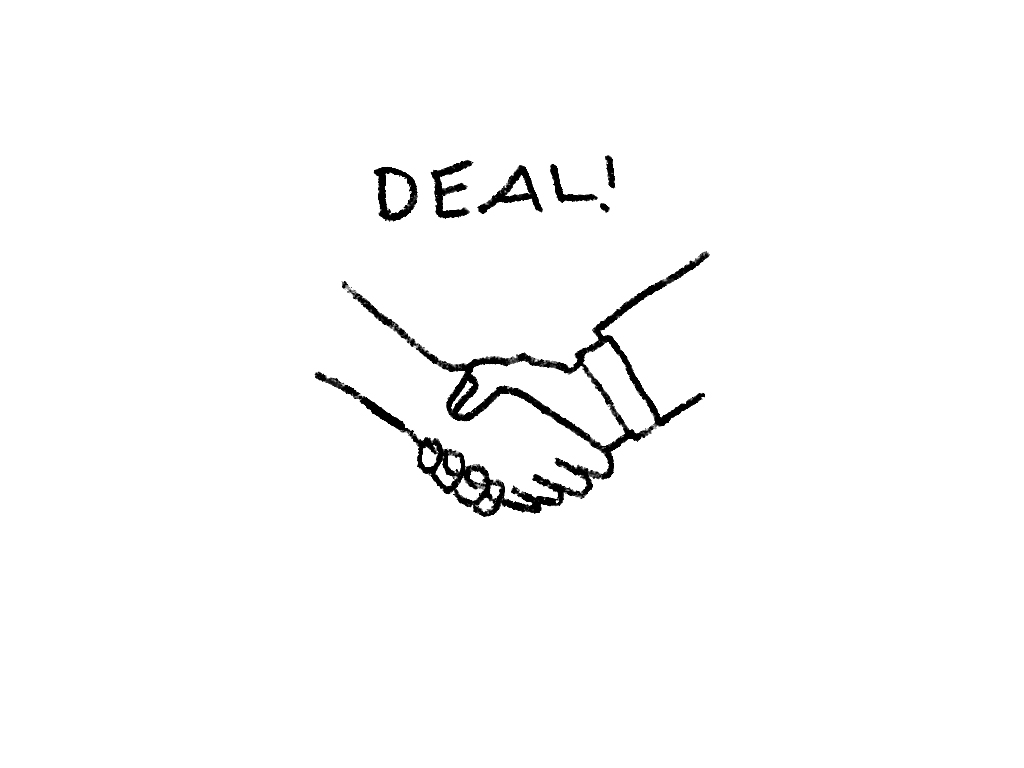
New Bike Day is one of the best experiences you can have as a mountain biker, and that includes new second-hand bikes. Armed with your new-found knowledge, you’ll be well-equipped to hunt down bargains. Buying a used bike can be a little more complicated, but it is usually worth the effort. If both buyer and seller treat each other with fairness, honesty and mutual respect, it will save a lot of stress and pave the way for a seamless agreement that will get you out on the trails in no time.
Did you enjoy this article? If so, we would be stoked if you decide to support us with a monthly contribution. By becoming a supporter of ENDURO, you will help secure a sustainable future for high-quality mountain bike journalism. Click here to learn more.
Words: Rudolf Fischer Photos: Various









